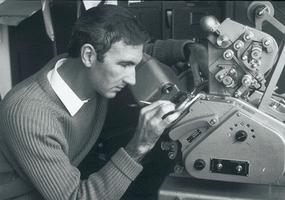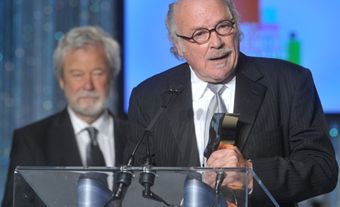National Film Board of Canada
The creation of the National Film Board of Canada (NFB) is the central event in the history of Canadian cinema. The NFB has pioneered developments in social documentary, animation, documentary drama and direct cinema; and it has been a continuing initiator of new technology. Its films have won hundreds of international awards. The NFB was founded 2 May 1939 under the terms of the National Film Act and following a report on government film activities by John GRIERSON, who was appointed the first film commissioner in October 1939. The act was revised in 1950, primarily to separate the NFB from direct government control; this revised act included the NFB's mandate to interpret Canada to Canadians and other nations.
The NFB was originally designed as a modestly staffed advisory board, but the demands of wartime production, together with John Grierson's personality, led to a shift into active production by absorbing (1941) the Canadian Government Motion Picture Bureau (formerly the Exhibits and Publicity Bureau, established in 1919). By 1945 the NFB had grown into one of the world's largest film studios with a staff of 787. More than 500 films had been released (including 2 propaganda series, The World in Action and Canada Carries On, shown monthly in Canadian and foreign theatres), an animation unit had been set up under the supervision of Scottish-born animator Norman MCLAREN, non-theatrical distribution circuits were established and many young Canadian filmmakers trained.
John Grierson resigned in 1945 and was replaced by his deputy, Ross McLean, who faced considerable difficulties in the postwar years. Budgets and staff were reduced and the NFB came under attack for allegedly harbouring left-wing subversives and as holding a monopoly that threatened the livelihoods of commercial producers. McLean's replacement (1950), Arthur IRWIN, calmed the storm, initiated a new National Film Act, restructured the NFB along modern bureaucratic lines and planned to move the NFB from Ottawa to Montréal (completed 1956 under Irwin's successor, Albert TRUEMAN).
Also during the postwar decade, production expanded into new areas: the first dramatic films were made, new techniques were explored in animation, and the information film and production for TV were initiated. Filmmakers paid more attention to style and technical polish, and new approaches emerged, more intimate in tone than the didactic approach of the war years. These were clearly evident in the films of one production group, Unit B, headed by Tom DALY, whose work led in the late 1950s to the world's first consistent use of direct cinema in the Candid Eye TV series (14 films produced for and broadcast on the CBC, 1958-61).
In Québec the NFB was viewed for some years as a federalist agency that denied Québec's cultural aspirations. French-language production was minimal until the late 1950s when the demands of TV and the move to Montréal provided catalysts for expansion. Many young Québec filmmakers - Pierre PERRAULT, Gilles CARLE, Michel BRAULT, Gilles GROULX, Claude JUTRA, Denys ARCAND and others - were hired; they played seminal roles in the flowering of Québec cinema in the 1960s, both within and outside the NFB. These filmmakers refused to accept the anglophone domination of the NFB's administration.
After a series of protests, the appointment of the first French-speaking commissioner, Guy Roberge, initiated a series of changes that culminated (1964) in a total separation of production along linguistic lines.
Women filmmakers made major contributions during the war years but were then virtually absent from active production until the early 1970s. Encouraged by such series as En tant que femmes (1972-75) and Working Mothers (1974-75), and the development of Studio D under Kathleen SHANNON, women have since made significant contributions both as directors and technicians. Indigenous peoples objected for many years to the folkloric and condescending images of themselves projected in NFB films. Only in the late 1960s, in such programs as Challenge for Change, did a truer portrait emerge. At the same time, First Nations people were given access to NFB equipment to produce their own films. These initiatives later led to such films as Gil CARDINAL's Foster Child (1987), Alanis OBOMSAWIN's Kanehsatake: 270 Years of Resistance (1993), and Zacharias KUNUK's award-winning feature ATANARJUAT - THE FAST RUNNER (2001), a co-production of the NFB and the Aboriginal Peoples Television Network.
In the late 60s the National Film Board decided it was time that First Nations got to be behind the camera and in charge of how they were seen. Although short lived, the Indian Film Crew would create films that changed how the NFB operated, as well as the face of Indigenous filmmaking in this country.
Note: The Secret Life of Canada is hosted and written by Falen Johnson and Leah Simone Bowen and is a CBC original podcast independent of The Canadian Encyclopedia.
This initial impetus towards an increasing accessibility to the means of production was continued through the 1970s as the NFB established regional production centres across Canada. Animation has always been an NFB priority and, though the work of such pioneers as Norman McLaren is widely recognized - his Neighbours won an Oscar for short documentary in 1953 - it has been the Board's continuing commitment to encourage new talent that has maintained the vigour of this section and made it one of the most admired in the world (see FILM ANIMATION). NFB film animators continue to win major festival prizes, such as those for Richard CONDIE's La Salla in 1997, Wendy Tilby and Amanda Forbis's When the Day Breaks in 1999 and Cordell BARKER's Strange Invaders in 2001.
Production of dramatic feature films for theatrical release began in 1963 with Don Haldane's Drylanders and has continued, despite debate about the appropriateness of such production within a state institution. Many NFB feature films have won international awards and have had wide release, such as Claude Jutra's MON ONCLE ANTOINE (1971; consistently ranked by critics as the best Canadian feature film ever made), Jean BEAUDIN's J.A. MARTIN, PHOTOGRAPHE (1977), and Denys Arcand's Oscar-nominated LE DÉCLIN DE L'EMPIRE AMÉRICAIN (The Decline of the American Empire) (1986); however, severe reductions in the NFB's budgets in the 1990s virtually eliminated this aspect of its program. The same budget cuts also forced the NFB to eliminate other programs and reduce its staff. A major review of its mandate in 2002 under a new film commissioner, Jacques Bensimon, emphasized digital production and distribution, the mentoring of young filmmakers, a renewed commitment to community involvement, and expanded partnerships with commercial producers. About half of all NFB productions and co-productions are now by emerging filmmakers. The NFB is also making extensive use of the Internet, winning a Webby Award in 2010 for its co-production, Kevin McMahon's Waterlife.
The once dominant position of the National Film Board has been significantly reduced since the 1960s by the growth of the commercial film industry and the expansion of television production. The Board's role in Canadian film has been further eroded by recent cuts to its budget. But it has been able to adapt to changing realities, attract talented new filmmakers, emphasize high qualities of production, and maintain its position as the world's most widely respected national film agency. NFB films have won nearly 70 Academy Award nominations and have been honoured with 12 Oscars, the first in 1941 for Stuart Legg's Churchill's Island and the most recent in 2005 for Chris LANDRETH's Ryan and in 2007 for Torill Kove's The Danish Poet. In 1989, the NFB won an honorary Oscar in recognition of its 50th anniversary and its record of filmmaking excellence.

 Share on Facebook
Share on Facebook Share on X
Share on X Share by Email
Share by Email Share on Google Classroom
Share on Google Classroom





